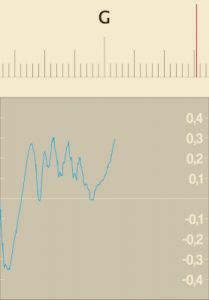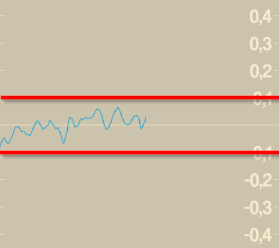Difficulty level: ★☆☆ (beginner)
The purpose of this exercise is to master the basics of a good long tone.
There are many different ways to play long tones. Let’s start with a “straight forte” low G:

Your sound should be as stable and solid as possible. Your sound volume should always be high, no crescendo, no decrescendo. Try to play as long as possible and visualize it in the Tuner.
At first, you may obtain something like this:

Here, the note started very low (-0.5 is a quarter tone under) and never really stabilizes. At the end of the long tone, the pitch gets high, this a standard behavior when getting out of air.
Your goal for this exercise is to:
- Stay as close as possible to 0.0 line (where you play perfectly in-tune).
- Start the long tone directly in tune.
- Stay in tune at the end of the long tone, even when getting out of breath.
After some practice, you should be able to stay in the -0.1/+0.1 zone:

How long your long tone should last depends on your lungs capacity, but also on your mouthpiece and reed, so don’t be concerned if you can’t make it across the screen! Just play loud and as long as you can.
Once comfortable with the “straight forte“, you can add some dynamics, for example:
- The bell-shaped

- The pianissimo to fortissimo

- The fortissimo to pianissimo

Here, ppp means that your sound is so quiet that you basically just hear air. And fff means as loud as you can.
By adding dynamics to your long tones, you may notice that your pitch gets higher when playing louder. Like before, you should stay in the -0.1/+0.1 zone.
Once comfortable with the dynamics, you can switch to the Long tones screen to check that your tone also is stable.
Of course, low G is not the only note to work on, you should be comfortable on all the notes of the register.
And yes, that is a lot of work…
